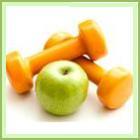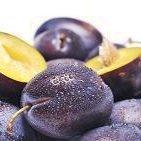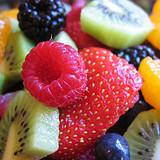Prune and Plum Nutrition,
Health Benefits of Plums and Prunes
All about plum nutrition information, prunes nutrition information, health benefits of plums, prunes and prune juice
Plums are a gorgeous sweet and tart fruit, similar in size to an apricot but with a smooth skin. There are many varieties, and each has its own distinctive color. There are varieties that are green, yellow, red and purple. Plums contain a stone which is toxic, so throw it away. One variety, sloe, is used to make sloe gin.
Dried plums are known as prunes. We’ve included the nutrient data of both plums and prunes below so you can compare. One serving of plums (100g or 3.5oz) contains 46 calories with very little fat and no cholesterol. Prunes though contain 240 calories as they have a lot less water. Plums and prunes make a fantastic healthy snack but don’t eat too many prunes given their high calorie content. Plums and prunes contain oxalic acid, so eat in moderation.
Comparing the nutrients of fresh and dried, the prune has a higher concentration of nearly every vitamin and mineral with the exception of vitamin C. So plums provide a good source of vitamin C and a modest amount of vitamin A. However, one serving of prunes provides a good amount of the B vitamins, especially B3 (niacin), B2 (riboflavin) and B6. They are loaded with vitamin K and also provide a good amount of vitamin A, magnesium, manganese, potassium and copper.
Plums, and especially prunes, are full of fiber and great for our digestion and preventing constipation. Also consider drinking prune juice as they rank second in soluble fiber content. The University of California claims prunes will help lower your LDL cholesterol. Prunes also contain traces of boron which help gives us strong bones and prevent osteoporosis. Plums are thought be very good for our liver.
When buying prunes try to buy and eat ‘fresh’ sulphite free to maximise the nutrient content. You can tell a plum is ready when it looks plump and the skin has a matt color. If the skin is shiny then it is not yet ripe. The plum will continue to ripen once purchased, but they will go off after a few days.
Compare plum nutrition facts to the other fruits.
 |
 |
Nutritional Value of Plums and Prunes
| Plum nutritional value per 100 g (3.5 oz) | ||
|---|---|---|
| Proximates: | ||
| Nutrient | Plums, raw Refuse: 6% (Pits). Scientific Name: Prunus spp | Prunes, dried, uncooked |
| Water | 87.23 g | 30.92 g |
| Energy | 192 kJ (46 kcal) | 1006 kJ (240 kcal) |
| Protein | 0.70 g | 2.18 g |
| Carbohydrates | 11.42 g | 63.88 g |
| Total Fat: | 0.28 g | 0.38 g |
| Fiber | 1.4 g | 7.1 g |
| Cholesterol | 0 mg | 0 g |
| Minerals: | ||
| Calcium, Ca | 6 mg (0.6%) | 43 mg (4.3%) |
| Iron, Fe | 0.17 mg (1%) | 0.93 mg (5%) |
| Magnesium, Mg | 7 mg (2%) | 41 mg (11%) |
| Phosphorus, P | 16 mg (2%) | 69 mg (7%) |
| Potassium, K | 157 mg (3%) | 732 mg (16%) |
| Sodium, Na | 0 mg | 2 mg (0.09%) |
| Zinc, Zn | 0.10 mg (0.7%) | 0.44 mg (3%) |
| Copper, Cu | 0.057 mg (3%) | 0.281 mg (14%) |
| Manganese, Mn | 0.052 mg (3%) | 0.299 mg (15%) |
| Selenium, Se | 0 mcg | 0.3 mcg (0.4%) |
| Vitamins: | ||
| Vitamin C | 9.5 mg (16%) | 0.6 mg (1%) |
| Thiamine (Vit. B1) | 0.028 mg (2%) | 0.051 mg (3.4%) |
| Riboflavin (Vit. B2) | 0.026 mg (1.5%) | 0.186 mg (11%) |
| Niacin (Vit. B3) | 0.417 mg (2%) | 1.882 mg (9%) |
| Pantothenic acid (B5) | 0.135 mg (1%) | 0.422 mg (4.2%) |
| Vitamin B6 | 0.029 mg (1%) | 0.205 mg (10%) |
| Folate (Vit. B9) | 5 mcg (1%) | 4 mcg (1%) |
| Vitamin A | 345 IU (7%) | 781 IU (16%) |
| Vitamin E | 0.26 mg (1%) | 0.43 mg (2%) |
| Vitamin K | 6.4 mcg (8%) | 59.5 mcg (74%) |
| Percentages are relative to US Recommended Daily Intake (RDI) for adults. | ||
Author: Lana Soko
You Might Also Like:
Like This Page?
|
Share This Page:
|
Search Our Site:

Free E-Book:
We Recommend:
Looking to get your body into great shape? Get the very best results for your efforts and money! Save your valuable time from surfing the internet. These are theBestselling Weight Loss Programs

Programs that work and have thousands of satisfied customers worldwide!

 |




